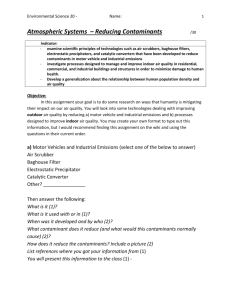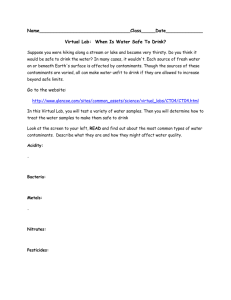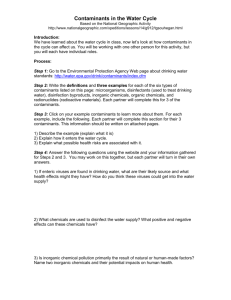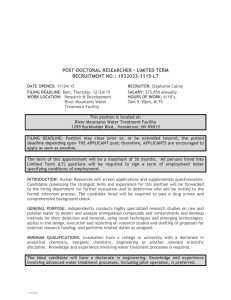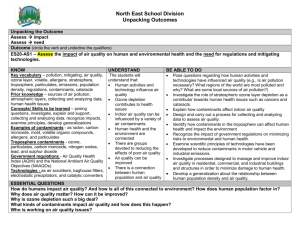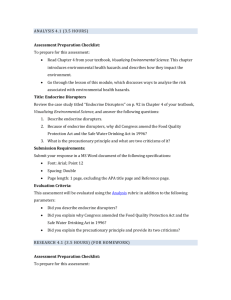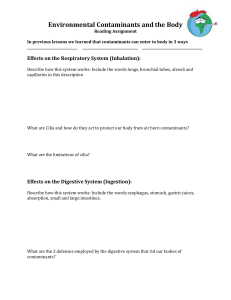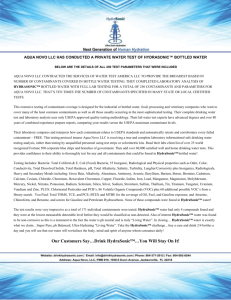IV.c. - Draft Research MS
advertisement
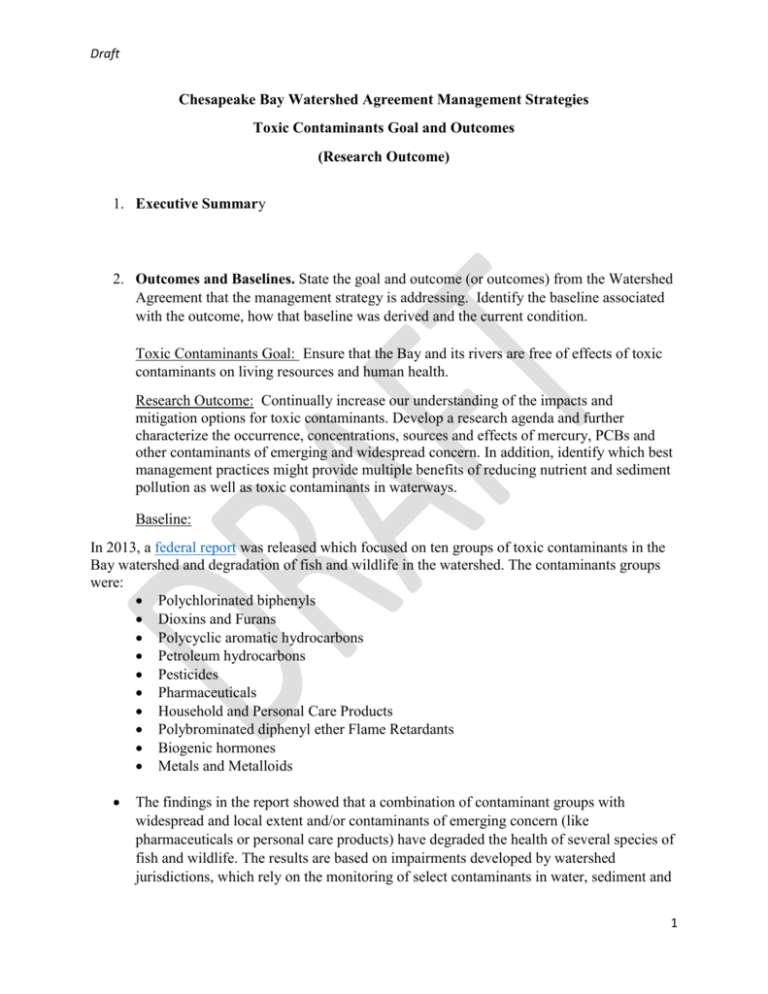
Draft Chesapeake Bay Watershed Agreement Management Strategies Toxic Contaminants Goal and Outcomes (Research Outcome) 1. Executive Summary 2. Outcomes and Baselines. State the goal and outcome (or outcomes) from the Watershed Agreement that the management strategy is addressing. Identify the baseline associated with the outcome, how that baseline was derived and the current condition. Toxic Contaminants Goal: Ensure that the Bay and its rivers are free of effects of toxic contaminants on living resources and human health. Research Outcome: Continually increase our understanding of the impacts and mitigation options for toxic contaminants. Develop a research agenda and further characterize the occurrence, concentrations, sources and effects of mercury, PCBs and other contaminants of emerging and widespread concern. In addition, identify which best management practices might provide multiple benefits of reducing nutrient and sediment pollution as well as toxic contaminants in waterways. Baseline: In 2013, a federal report was released which focused on ten groups of toxic contaminants in the Bay watershed and degradation of fish and wildlife in the watershed. The contaminants groups were: Polychlorinated biphenyls Dioxins and Furans Polycyclic aromatic hydrocarbons Petroleum hydrocarbons Pesticides Pharmaceuticals Household and Personal Care Products Polybrominated diphenyl ether Flame Retardants Biogenic hormones Metals and Metalloids The findings in the report showed that a combination of contaminant groups with widespread and local extent and/or contaminants of emerging concern (like pharmaceuticals or personal care products) have degraded the health of several species of fish and wildlife. The results are based on impairments developed by watershed jurisdictions, which rely on the monitoring of select contaminants in water, sediment and 1 Draft fish tissue. See appendix 1 for more detailed information on extent and severity of the contaminant groups. Since the report, there have been additional findings on the extent of intersex conditions in the bay watershed as well as wildlife impacts and occurrence of toxic contaminants. 3. Jurisdictions and agencies participating in the strategy The Toxic Contaminants Workgroup (TCW) has succeeded in extensive outreach and engagement of a wide array of stakeholders. Bay Agreement signatories and stakeholders who have indicated their intention to participate in management strategy development have been identified on the workgroup membership list. The membership of the TCW includes members from the following groups: Maryland Department of the Environment Maryland Department of Natural Resources Virginia Department of Environmental Quality DC Department of the Environment Pennsylvania Department of Environmental Protection Delaware Department of Natural Resources and Environmental Control New York Department of Environmental Conservation West Virginia Department of Environmental Protection Federal Agencies: EPA, USGS, FWS, DHS, NOAA Non-Governmental Organizations Private sector organizations Local government organizations Academic institutions CBP Water Quality Goal Implementation Team Workgroups 3.a Local Engagement Most of the actions to plan and complete the actual research is expected to be the responsibility federal, state and academic entities. Local governments and NGOs will be helpful in identifying priorities within the agenda. The TCW expects to maintain active members and to pursue partnerships with local organizations to inform the agenda. The workgroup has made a concerted effort to include representatives from local areas such as the Baltimore Harbor, the Elizabeth River, and the Anacostia River. 4. Factors influencing ability to meet goal. Research Outcome Factors Lack of watershed-wide monitoring programs on the condition of fish and wildlife and occurrence of toxic contaminants. No consolidated information sources of existing data High cost of generating new data for on toxic contaminants and associated biological monitoring. 2 Draft Ability to determine which pollutants are causing the degradation of fish and wildlife due to wide range and mixtures compounds occurring in the watershed. Lack of toxicity thresholds for some pollutants Inability to assess risk for mixtures of pollutants 5. Current Efforts and Gaps There are some ongoing studies in the Bay watershed on toxic contaminants and their effects on fish and wildlife. Selected studies and monitoring include: Documenting the extent of intersex conditions in the Potomac and Susquehanna watersheds and relation to toxic contaminants. Understanding the role of toxic contaminants and other factors in fish kills in the Bay watershed. Assessing the effects of endocrine-disrupting compounds on fish and wildlife. Monitoring to assess impairments in state waters Monitoring programs for selected contaminant groups (such as pesticides) A more detailed listing of current efforts can be found in appendix 2. NOTE: This can include research both in the watershed and research outside of the watershed that is relevant. An initial assessment of the level of uncertainty associated with the 10 contaminant groups was conducted to help assess gaps. Attachment 1 shows the level of certainty with regard to the occurrence, concentrations, sources and effects on fish and wildlife. The gaps in research will be further identified through development of a research agenda (see next section). Example gaps include: Understanding of the implications of contaminant groups mixing. Identification of sources and inputs of the contaminants. Primary contaminants effecting fish and wildlife 5.a Actions, tools or technical support needed to empower local government and others. Identify specific actions, tools or technical support needed at the local level. 6. Management Approach The research agenda, which is presented in this section, is the primary mechanism for the management approach. The issues addressed in the research agenda are: a. Safety of fish for human consumption: PCBs and Hg are the primary causes of fish consumption advisories. Further research may be need on their sources and transport to waterways. b. Fish kills: assess the role of contaminants and other factors, such as algal toxins related to high nutrients, causing fish kills in the watershed. 3 Draft c. Fish health: Determine the primary contaminants degrading fish health, including intersex, compromised reproductive systems, tumors, and skin lesions. d. Begin to assess effects of EDCs on fish and wildlife and potential human health concerns e. Better understand the effects of contaminants on pollinators and other selected wildlife species. f. Mitigation options: for the contaminants found to have the primary effects on fish and wildlife we will explore mitigation options to reduce their impacts. One of the first activities will be assessing nutrient and sediment BMPs for their potential benefits to reduce contaminants. Guiding principles for carrying out the research agenda include: Focus studies on areas where fish and wildlife have been degraded and their area human health concerns. Better understand and identify the multiple stressors and mixtures of contaminant groups contributing to problem Identify sources and inputs of contaminants and stressors. o Utilize existing TMDLs that have been issued to better identify sources and inputs of contaminants. Complete the planned study for identifying which best management practices provide multiple benefits of reducing nutrient and sediment pollution as well as toxic contaminants. Provide implications for reducing effects of the stressors and contaminants. o Address stresses and mixtures o Assess opportunities for nutrient and sediment reductions efforts (such as phase 3 WIPs) to reduce contaminant effects. o Compile “success” stories 6.a Local Engagement (This text is retained to guide further development of this section) If relevant, describe what steps will be taken to facilitate greater local participation, including underserved and underrepresented communities as a way to include more diverse participation, in achieving the outcome, including what actions, tools or technical support will be provided to empower local governments and others to do their part. 7. Monitoring Progress Two types of progress monitoring will be pursued: 1) Progress on completion of planned activities for actions not directly under the direction of the Partnership and progress for activities for which the TCW is directly committing to oversight and dedication of resources of the Partnership 2) Assessment of whether planned actions are resulting in continual improvement of knowledge of occurrence, concentrations, sources and effects for the highest priority 4 Draft pollutants and whether the research agenda outcome is integrated with the policy and prevention outcome in a way that provides the information needed for future prevention strategies (i.e., beyond PCB reductions). 8. Assessing Progress For type 1) progress monitoring as described above, the frequency of assessing progress will be at least annual so that adjustments to the biennial workplan can be made to accommodate changing circumstances and availability of resources. Formal review of type 1) progress data will be completed through the update of the biennial workplan. Progress assessment based on type 2) monitoring will be conducted at a similar frequency as type 1) recognizing that the planning, completion and publishing of research is usually a multi-year process. Therefore, it is not expected that there will be rapid advancement in gaining more knowledge to reduce uncertainty. 9. Adaptively Manage Adaptive management will focus on whether planned research is on schedule and is being completed (type 1 monitoring above) and whether new information is attained that shifts the TCW’s view on priorities. It is also possible that the needs of the kind of information to use in the policy and prevention outcome will influence adaptation of the research agenda. New technologies to be utilized in research may prompt adaptions to the research agenda. 10. Biennial Workplan summarize the commitments, actions and resources that each jurisdiction, federal agency and partner will take to help achieve each of the outcomes Biennial workplan to be developed 5 Draft Attachment 1 – Conceptual Draft Appendix 1: Information on extent and severity of contaminant groups: Widespread extent: For polychlorinated biphenyls (PCBs), polycyclic aromatic hydrocarbons (PAHs), herbicides (primarily atrazine, simazine, metochlor, and their degradation products) and mercury, available information indicate widespread extent thought the Bay watershed. Localized extent: For dioxins/furans, petroleum hydrocarbons, some chlorinated insecticides (aldrin, chlordane, dieldrin, DDT/DDE, heptachlor epoxide, mirex), and some metals (aluminum, chromium, iron, lead, manganese, zinc), the report identifies localized extent of contamination. Uncertain extent: For pharmaceuticals, household and personal care products, flame retardants, some pesticides, and biogenic hormones, information was not adequate to determine extent Widespread severity: PCBs and mercury have impairments identified in all of the watershed jurisdictions, meaning concentrations are known to compromise the health and quality of aquatic organisms. PCBs and mercury also create a risk to human health through consumption of contaminated fish. Localized severity: For dioxins/furans, PAHs, petroleum hydrocarbons, some chlorinated pesticides (aldrin, chlordane, dieldrin, DDT/DDE, heptachlor epoxide, mirex), and some metals (aluminum, chromium, iron, lead, manganese, zinc), the report identifies localized severity based on impairments in a limited number of areas in the Bay watershed. 6 Draft Uncertain severity: pharmaceuticals, household and personal care products, flame retardants, and biogenic hormones, severity could not be determined. For many pesticides including herbicides that had widespread occurrence (atrazine, simazine, metochlor, and their degradation products), water-quality standards were not available to determine impairments for these contaminant classes. However, some research shows sublethal effects for some compounds at environmentally relevant concentrations. 7
